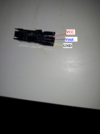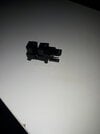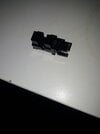Hello,
i am trying to use this Photointerrupter sensor:
https://www.sharpsde.com/fileadmin/...hotointerrupter/GP1A173LCS3F_DS_OP14021EN.pdf
Sharp 173
but i am getting always high on the Vout, i try on 5V and also on 3.3V
and i try also to change beetween the VCC and the GND.
but keep getting always high on the Vout.
according to the datasheet the Vout should be normaly low, anwhen the is blocking it should be high.
what am i missing here ?
best regards.
i am trying to use this Photointerrupter sensor:
https://www.sharpsde.com/fileadmin/...hotointerrupter/GP1A173LCS3F_DS_OP14021EN.pdf
Sharp 173
but i am getting always high on the Vout, i try on 5V and also on 3.3V
and i try also to change beetween the VCC and the GND.
but keep getting always high on the Vout.
according to the datasheet the Vout should be normaly low, anwhen the is blocking it should be high.
what am i missing here ?
best regards.



